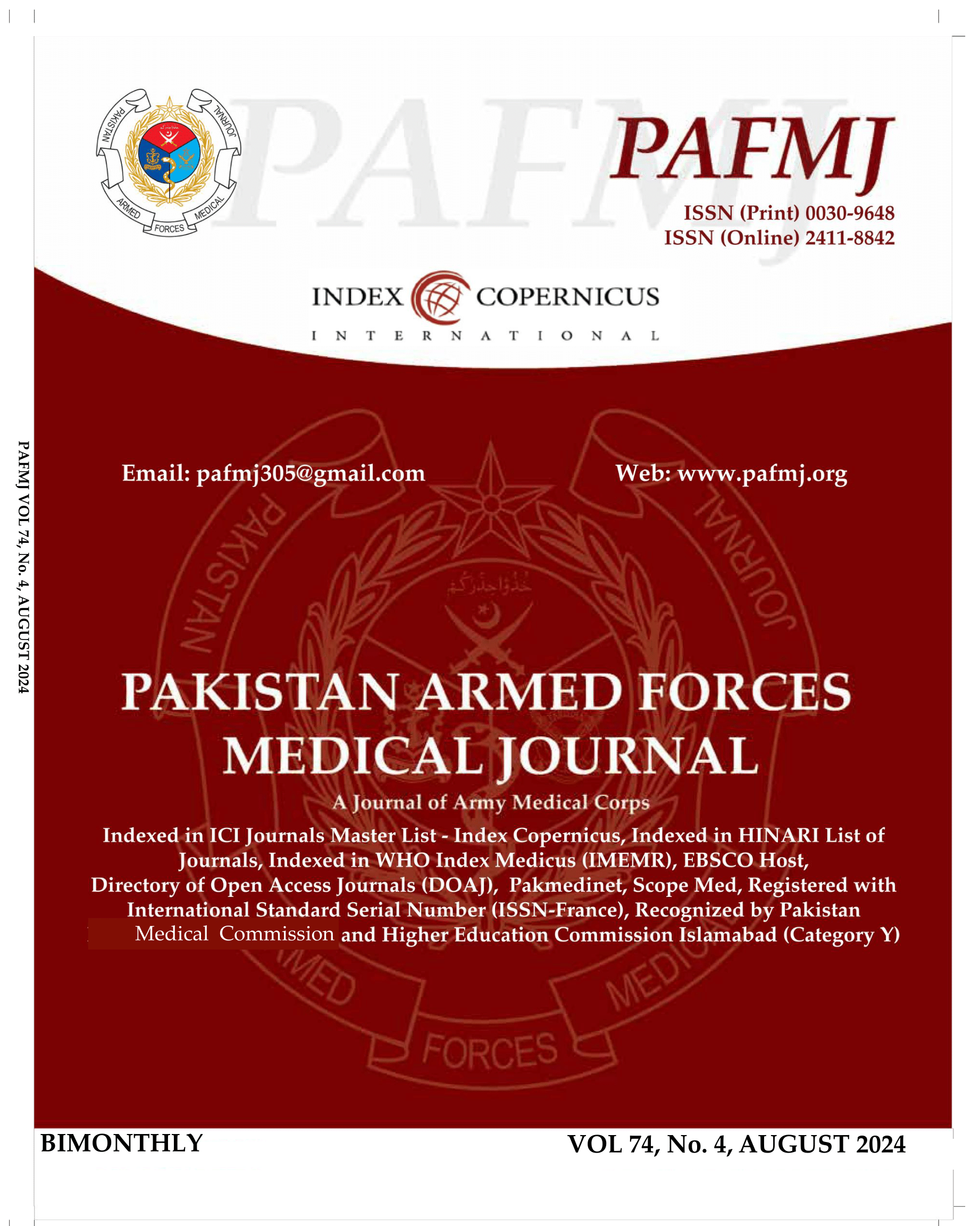Correlation of Electrophysiological and Behavioral Response in Cochlear Implant Candidates
DOI:
https://doi.org/10.51253/pafmj.v74i4.9670Keywords:
Auditory Steady State Response, Cochlear Implant, Hearing Loss, Patient Outcome Assessment.Abstract
Objective: To determine the effect of Cochlear Implants on electrophysiological and behavioural response in children with hearing impairment at frequencies of 500, 1000, 2000, and 4000 Hz.
Study Design: Cross sectional study.
Place and Duration of Study: Department of ENT, Combined Military Hospital Rawalpindi Pakistan, from Jul 2021 to Jul 2022.
Methodology: Seventy children with hearing impairment aged 2-12 years of either gender, who had undergone cochlear implantation were part of the study. Language and hearing conditions were examined during the audiological assessment of candidates for cochlear implantation. At ER-tone 5A and TDH-39 using ISO 389-2 and 389-1 calibrations, warble tones given at different frequencies were used to derive behavioral air conduction thresholds. The Auditory Steady State Response test began with a carrier frequency of 500 Hz and advanced to frequencies of 1000, 2000, and 4000 Hz. Thresholds were set using a 10 dB down and 5 dB up procedure until no responses could be captured. Behavioral and Auditory Steady State Response responses were noted in all patients.
Results: Mean age of the patients was 6.66±2.74 years. Behavioral threshold>110 dB HL were obtained in 8(11.4%) subjects, 10(14.3%) had behavioral thresholds from 100 to 110 dB HL, and 52(74.3%) had <100 dB HL. Eleven patients obtained Auditory Steady State Response thresholds>110 dB HL (15.7%), 31(44%) achieved 100 to 110 dB HL and 28(40%) achieved <100 dB HL. The most common frequency was 500 Hz. Statistically insignificant difference was found between .......
Conclusion: Cochlear implantation has positive effect on behavioral and ...
Downloads
References
Deep NL, Dowling EM, Jethanamest D, Carlson ML. Cochlear Implantation: An Overview. J Neurol Surg B Skull Base 2019; 80(2): 169-177.
https://doi.org/10.1055/s-0038-1669411
Jallu AS, Hussain T, Hamid WU, Pampori RA. Prelingual Deafness: An Overview of Treatment Outcome. Indian J Otolaryngol Head Neck Surg 2019; 71(Suppl 2): 1078-1089.
https://doi.org/10.1007/s12070-017-1181-7
Nandhan R, Ravikumar A, Kameswaran M, Mandke K, Ranjith R. A clinical study of electrophysiological correlates of behavioural comfort levels in cochlear implantees. Cochlear Implants Int 2014; 15.
https://doi.org/10.1179/1754762814Y.0000000064
Charroó LE, Bermejo S, Paz Cordovez AS, Rodríguez C, Finley CC, Saoji AA. Effect of Number of Electrodes Used to Elicit Electrical Stapedius Reflex Thresholds in Cochlear Implants. Audiol Neurootol 2021; 26(3): 164-172.
https://doi.org/10.1159/000510467
Vaerenberg B, De Ceulaer G, Szlávik Z, Mancini P, Buechner A, Govaerts PJ. Setting and reaching targets with computer-assisted cochlear implant fitting. Sci World 2014; 2014: 646590.
https://doi.org/10.1155/2014/646590
Rasmussen KMB, West NC, Bille M, Sandvej MG, Cayé-Thomasen P. Cochlear Implantation Improves Both Speech Perception and Patient-Reported Outcomes: A Prospective Follow-Up Study of Treatment Benefits among Adult Cochlear Implant Recipients. J Clin Med 2022; 11(8).
https://doi.org/10.3390/jcm11082257
Frosolini A, Badin G, Sorrentino F, Brotto D, Pessot N, Fantin F, et al. Application of Patient Reported Outcome Measures in Cochlear Implant Patients: Implications for the Design of Specific Rehabilitation Programs. Sensors 2022; 22(22): 8770.
Downloads
Published
Issue
Section
License
Copyright (c) 2024 Syed Bilal Hussain Shah, Zaimal Shahan, Maryiam Asghar, Mohammad Zubair Khan, Mohsin Raza, Wajih-ud-din Shinwari

This work is licensed under a Creative Commons Attribution-NonCommercial 4.0 International License.















